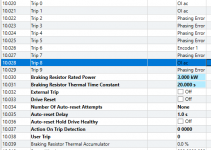1. Work with the utility to replace upgrade pole transformers: Done
2. Upsize ground wires and rebond to ground rods: Done
3. Check and bond the grounds on the drive cables: Done, ish.
There is a junction box between the drive and the motor that splits signals to a computer. The junction box is track mounted and has ground pins on the cable. I know that each end of the cable shielding is supposed to be grounded, but I don't know how the shield grounding of each cable at the junction is accomplished.
The cable from the drive to the junction, I verified the ground at the drive. From the junction to the motor, I verified the ground at the motor.
4. Look into easy start components to introduce between before the power supplies. <---- Here
5. Investigating upsizing the 240/400 transformer.
6. After grounding investigate via Emerson's on board scope to see if DC ripple is occuring
7. Ensure The secondary Y is separately derived and has a GEC to the ground rod (#6 max to the ground rod may meet code idk). The transformer secondary has a system bonding jumper that connects the neutral, the GEC, all other Earth ground systems nearby, the building steel, and the equipment grounding system.
8. Start to panic !
9. Investigate EMC filters
10. Investigate Line reactor(s).
11. Thermal Scanning
2. Upsize ground wires and rebond to ground rods: Done
3. Check and bond the grounds on the drive cables: Done, ish.
There is a junction box between the drive and the motor that splits signals to a computer. The junction box is track mounted and has ground pins on the cable. I know that each end of the cable shielding is supposed to be grounded, but I don't know how the shield grounding of each cable at the junction is accomplished.
The cable from the drive to the junction, I verified the ground at the drive. From the junction to the motor, I verified the ground at the motor.
4. Look into easy start components to introduce between before the power supplies. <---- Here
5. Investigating upsizing the 240/400 transformer.
6. After grounding investigate via Emerson's on board scope to see if DC ripple is occuring
7. Ensure The secondary Y is separately derived and has a GEC to the ground rod (#6 max to the ground rod may meet code idk). The transformer secondary has a system bonding jumper that connects the neutral, the GEC, all other Earth ground systems nearby, the building steel, and the equipment grounding system.
8. Start to panic !
9. Investigate EMC filters
10. Investigate Line reactor(s).
11. Thermal Scanning


